Table of Contents
Frank Bell - Trans-world Radio Contact
This page covers the history of the first ever trans-world two-way radio contact.
This contact was by Morse and was the first ever, trans-world two-way radio communication of any type. It was from Shag Valley Station, Waihemo, Palmerston, Otago and the contact was with Cecil Goyder G2SZ at Mill Hill School, London.
What Happened?
The following is a transcript of the log Frank Bell made for his amateur radio station Z-4AA on 18th October 1924.
G2SZ loud on about 100. A/C ripple in note. No interference and keying perfect and good operator. Stronger than most Yanks and very loud indeed at start, fading gradually. I had just cut flat top off aerial and shortened counterpoise. Using a 4 Meissner. Input 150 miliamps at 100 (?) volts. Radiation 1.1 on 92.5. Had not had report on new signals since altering aerial. Gave G2SZ a call just for something to do. 6.10 p.m. Heard G2Sz call V1XAV and say “but can’t hear him … am listening about 80 as heard No Dice . . . this morning. 1XAV UG2SZ. Terribly sorry old man, can’t hear you. Something is wrong this end so I am listening about 80. Try once again on 80. 1XAV UG2SZ. 6.25 p.m. (I then called him for about four minutes. – he came back.) 6.30 p.m. 4AAZ G2SZ. Received your message. If you are really Z4AA, cable. (I said sure would cable and sent congratulations also.) Another one to Radio Society of Great Britain. “Greetings from New Zealand, signed Bell Z4AA.” 6.35 p.m. 4AAZ G2SZ. Received you. Here is another one to New Zealand. “Greetings from us”. Can’t realise you are in New Zealand. Daylight now. Call tomorrow at 6.30 G.M.T. for me. Amateurs G2SZ. Are you troubled by static? or fading? Will you cable address? 6.40 p.m. I sent my address “Bell, Waihemo” and he said daylight still here. Call him tomorrow. Nil fading. Very little static. Gave my input 150 watts and sent another two to G2OD. 6.45 p.m. 4AAZ G2SZ. (Greetings call) Address Goyder, Mill Hill School London. Input 200(?) watts, and gave radiation etc. No Dice from him in reply . .”
Within hours Frank Bell was inundated with congratulatory telegrams, call cards and letters.
Frank Bell in the clear air of the Shag Valley, Otago, had achieved what no-one had done before – around the world wireless communication. Remember at that time the USA had not communicated with their antipodes, and neither had Australia nor Canada.
The wireless companies, already in possession of air time and armed with laws preventing interference by amateurs had not been able to open up communications – this particular achievement was left the Hams to make!
These days we think nothing of having at our command instant Morse, telephone and wireless communication between people resident around the globe.
40th Anniversary (1964)
The follow text has been extracted from the NZART Official Journal Break-In published in 1964.
In perfect weather and before a crowd of 100 people, the fortieth anniversary of the first trans-world radio contact was celebrated at the Shag Valley Station on Sunday, the 18th of October. (1924)
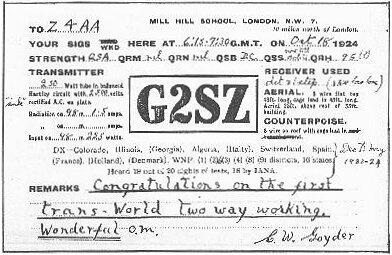
Commemorating the first QSO between Frank D. Bell, 4AA and Cecil W. Goyder, 2SZ, a plaque was unveiled by NZART President C. G. Liddell, ZL3ND, of Christchurch.
This was the culmination of weeks of work by the Otago Branch who must have been justly proud of the result of their endeavours.
Amateur operators from Wellington to Invercargill witnessed the ceremony which was held at the gates of the Bell’s station, about 17 miles from Palmerston South. The large contingent of members who travelled from Christchurch (including Tom Clarkson, ZL2AZ of Wellington) met local and Invercargill visitors at the Dunback Domain for a picnic lunch before travelling to the site.
The ceremony which started at 2 p.m was opened by Fourth District Vice-President David Lloyd, ZL4PG, who welcomed visitors on behalf of the Association and the host Branch, Otago.
Messages and greetings were read by him from the following:
Mr Cecil W. Goyder, ex 2SZ (who now lives in New York). In his letter, Goyder sent greetings to the Bells, NZART and the Radio Society of Great Britain. Unfortunately he was unable to come on air later to take part in the commemoration transmission made to England.
From Mr T. K. S. Sidey, ZL4AZ who sent greetings from himself and from the City of Dunedin.
From Ralph Slade, ZL2BK of Wellington, who was unable to attend because of illness, as was Mr H. N. Shrimpton, ZL2AUM of Wellington.
A telegram was received from Mr T. C. Middlemiss, ZL4BN of Dunedin, a message of congratulations from Mr R. T. Woodfield, ZL2VN of Palmerston North, and letters from Mr L. S. Spackman, ZL1AC of Auckland and Mrs Blackwood, wife of the late Mr Blackwood who assisted Frank Bell to erect the famous tower at the homestead.
A cablegram, “tie me aerial down, sport, good luck for today” came from Frank’s son in Queensland. It was signed “Cleopatra….” in reference to the shape of the support for the plaque.
From Newington, Connecticut, came the cable “Hearty congratulations on historic anniversary and best wishes for many more years of Amateur Radio” and was signed the American Radio Relay League.
The first speaker was Alan Frame, ZL4GA of Invercargill, who spoke in his capacity as Grand Old Man of the Old Timers’ Club.
In his speech, Alan referred to the great pioneering work done by the early operators of this country. In referring to the problems of the early men he said, “There was a shortage of radio components in those early days. Even the more simple components had to be fashioned by hand. They were tried and often found not to work, but experimenters learned to try again…..”
Alan then referred to the great contribution made to radio by Frank Bell and praised the spirit and determination shown by him from the start.
His excellent speech was received warmly by the crowd.
Next, Mr H. N. Griffin, District Engineer for the New Zealand Post Office at Dunedin, spoke.
Deputising for the Director General, Mr Griffin apologised for the absence of Mr Darnell who was unable to be present owing to a prior engagement and conveyed his greetings and congratulations to the Bells.
Mr Griffin paid a fine tribute to Mr Bell and his pioneering work forty years ago and passed best wishes from the Post Office on this most historic occasion.
Earlier, Mr Griffin had startled the gathering with the statement that he had been told by ZL4PG that he was only to say two words!
This he did….. “Thank you!”
The President of NZART, Mr Clive Liddell, ZL3ND, of Christchurch, was introduced.
In tracing the history of Amateur radio and Amateur achievement from the earliest days when everything was experimental and often far from practical, Mr Liddell referred to the great contributions Frank Bell had made to the science in New Zealand and the impact of this knowledge throughout the world.
In describing the event to the assembled guests, the President pointed out that not only was this the first Amateur radio contact around the world but it was in fact the first radio transmission of any kind to be sent and received at such a distance. “This Amateur achievement showed the whole world the practical use of shortwave communication, It was, indeed, a most significant contribution.”
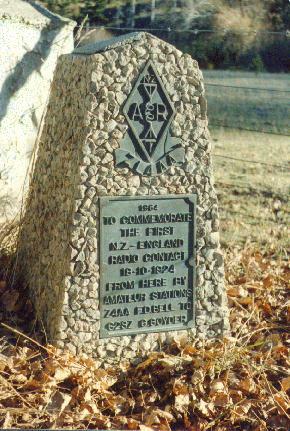
Mr Liddell then unveilled the plaque which had been draped with the flags of Great Britain and New Zealand.
“It is with the greatest of pleasure, then, that I unveil this plaque,” he said, to the applause of the crowd.
Cameras clicked and movies whirred as the striking monument to the historic occasion was revealed.
In his reply, Mr Frank Bell, who was visibly moved by the occasion, thanked the Amateurs of New Zealand and those who were responsible for the commemoration.
“My sister and I are deeply moved by this touching tribute to us,” he said. “We are delighted and in fact a little amazed that you have remembered it at all.”
Speaking of the early days he said, “It was a lot of fun and we had a lot of help from others who were as keen as us. Jack Orbell, Miles Barnett, Bill Crockett, Lalor Shiel and Ralph Slade made up the team with us and we had a wonderful time. I expect I was lucky; Ralph (Slade) and Lalor (Shiel) worked into England the next night.”
In his typically unassuming and gentle manner he added, “You know, without them I don’t think we would have made it.”
“I would also like to thank all those who sent messages and greetings to us,” he continued. “It was wonderful to receive telegrams and letters from Cecil Goyder, Ralph Slade and all those other fine people who remembered us. It certainly brings back memories of those old days, and we appreciate it very much.”
Immediately after Frank’s reply, Alan Frame asked if he would become Patron of the Old Timers’ Club. When Frank replied that this would be a great honour, he was presented with the Certificate of Membership to loud applause.
David Lloyd moved to the microphone again.
“In doing research into the background of this occasion,” he said, “I have been greatly assisted by the Bells. I am not in the habit of quoting from ladies’ private diaries but I would like to quote the first five words at the top of Miss Bell’s diary of October 18th, 1824. It says: “My birthday; champagne dinner tonight’.”
At this, Mr H. G. Hedge, presented bottles of champagne to both Frank and Brenda on behalf of the Otago Branch.
An invitation was then extended from the Bells to visit the homestead and the shack before afternoon tea.

Equipment, including the original Meissiner transmitter built by Frank Bell, French “R” valves, 202’s, 203’s, ex-World War I. generators used for power supplies, and an extremely old and once quite operative tape recorder, were displayed.
The old timers present were amazed at the gear shown and many nostalgic memories were revived.
Literally hundreds of photographs were taken and groups of “Hams” talked excitedly of the days of home-made condensers, raw AC and “all that space 200 metres and down.”
Many people took the opportunity to look about the grounds of the Bell home, watching the three and four pound trout swimming in the pool and admiring the beautifully-kept gardens. Afternoon tea was then served by the Bells.
To further commemorate the occasion, a commemoration transmission to England had been arranged for 6.30-the time of the original QSO. ZL4FD’s National NCX3 SSB transceiver had been installed in the reading room and, earlier in the day, an 80 metre folded dipole had been slung 70 feet high between two trees, and the feeders and ZL4LV’s antenna tuner installed.
The contact station in England was G8PO in Hillend, near Portsmouth.
ZL4PG had arranged through the Radio Society of Great Britain that other British stations could possibly come on the air at the time.
David worked G8PO with loud and clear signals with the same gear on the previous night, but conditions on the Sunday night really let everyone down.
G8PO could be heard at times but VE’s, YV’s and other DX stations almost completely blotted out Ted’s transmissions.
Then Frank, ZL4LM, with his vertical antenna at Invercargill, assisted and later relayed signals from England. After shifting to almost 3.8 mcs a relatively clear channel was found and the contact commenced, using the Otago Branch callsign, ZL4JY.
The response from England was staggering! Firstly GB3BI called with greetings from the Boy Scouts of Great Britain. He was followed by G3BA with messages from the VHF operators of the Midlands.
G2PU followed with congratulations from the DX men of England while G2BVN called with greetings from the Headquarters of the Radio Society of Great Britain. GW5SA then called to pass congratulations from the Amateurs of Wales and was followed by G3GEW with a message from the Amateurs of the South of England.
Then followed DJ4WN, Alfred from Heidelberg who passed the congratulations of the Amateurs of Germany and G5BJ followed with a personal message. G5BJ had become interested in radio in 1916 and had worked the Bells in the very early days.
Frank and Brenda were astounded by the interest shown in Great Britain and passed their most sincere thanks to the operators in England and Germany via ZL4LM. Frank, at the microphone, also thanked G8PO and ZL4LM for their part in making the contact possible. The QSO concluded at 1945 hours when the British signals were starting to fade.
Sincere thanks must also be passed to the Press and the New Zealand Broadcasting Corporation for the most generous publicity given to this occasion.
The NZBC sent announcer Ray Schofield and Technician Jim Leckie to Shag Valley where they recorded and compiled an excellent 15 minute programme “Calling England”.
This was played over 4ZB Dunedin at 9.40 that evening and the next night played Nationally. Reference was also made in three National news bulletins during the night.
An excellent television film was made of the ceremony by producer Michael Minehan and cameraman Ken Lloyd. This was first shown on the early news telecast at 7.30 p.m. and a further item shown on the late news programme. It was seen on Channels 1, 2, 4, 5, and 6 in the Otago-Southland area that night and Nationally the next night. Arrangements were made, I understand, to send this material overseas.
The Press of Dunedin and the Press Association also assisted us. Four stories were run in Dunedin, including a half-page feature article entitled “Otago ‘Ham’ made history.
Without doubt, the ceremony could not have taken place without the excellent work of the Otago Branch.
The monument, designed and pre-cast by Jeff Walker, ZL4DH, was a magnificent piece of work.
The four-sided monument was cast in concrete with pink stone chip decoration. Seated on a concrete base, it stands over two feet high. On the face at the top is a replica of the NZART badge with Frank Bell’s call, ZL4AA, inscribed.
The plaque bears the inscription: 1964. To commemorate the first N.Z.-England radio contact, 18.10.24 from here by Amateur stations Z4AA F.D.Bell to G2SZ C.Goyder.
The bronze plates were also cast by Jeff.
A group of the Dunedin Amateurs took it to the site on the Saturday and completed it there.
George Hedge, ZL4FD most generously assisted with the radio and electrical equipment used at all times and other members cheerfully assisted in every way to make the occasion the success it doubtless was.
95th Anniversary (2014)
4AA and the 90th anniversary of Frank Bell’s contact with the Cecil Goyder in the UK occurred at Shag Valley Station from 11th - 18th October, 2014.

Otago Branch 30 of NZART, who incidentally have long recognised this achievement with the club call sign ZL4AA, having been planning a special event station at Shag Valley Station since last year. We also have a Memorial Cairn at the gates of the station to further commemorate the historic event.
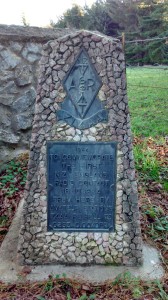
Club members have recently visited the station and met with the current landowners, 6th generation Bell family, and descendants of the original operator, Frank Bell. The family have been enthusiastic in supporting Branch 30 in setting up a commemorative station on the site for the week leading up to the 18th October, 2014. They have agreed to our use of their shearer’s quarters for accommodation for the period.
The site is in a hollow in a rural area with high surrounding hills making VHF, UHF and mobile phone communication difficult or impossible.
Therefore, initial plans have focused on installing a vertical mast for 80m operation, close to the original frequency, 92.5 metres, or 3.243 MHz approximately.
However, we are also exploring VHF and UHF options to get contact back to Dunedin’s Mt Cargill amateur installations which open up the means to access the National System and a Dunedin based IRLP which would offer further worldwide contact.
We are applying for the special call sign Z4AA for the week, 11th to 18th October, to be used from Shag Valley Station as 4AA is not available being the current prefix for Mexico.
The British with the support and help of RSGB are mounting a number of operations with a major effort from the site of the original contact, Mill Hill School, using the original call sign 2SZ from the 11th to 18th October. We would like to have more bands operational, but even manning 80 and VHF/UHF will stretch our resources so we invite any other amateurs or amateur groups wishing to be a part of this unique event to contact us at president@zl4aa.org.nz.
If any group is prepared to come complete with all the gear to operate other HF bands, we would be delighted to welcome you. We are also exploring the options for campervans to be parked on site for the duration.
Antenna Setup
Hi team!
Despite the rather indifferent weather forecast, the decision to carry on was made and although we didn’t make the 10 am start, by the time most of us made it to Shag Valley Station, Lindsey and his team had the coal range stoked up and the jug boiling. That smoke whisping from the chimney as we arrived was a great sight.
A few rain drops on the way and a couple of drops late in the day was the closest we saw to the really lousy weather elsewhere. It was most definitely better at the station so maybe that’s a good omen for the big event coming up.
While a bit windy, conditions were not at all bad.
And the good news. Dave Mulder and his team has the 80 metre mast up, with the matching unit all checked and some power from the mighty Yeasu satisfactorily fed into it – roll on the contacts!
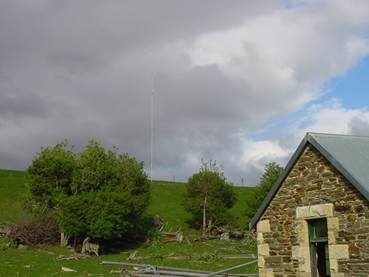
The ZL4JH team has the lattice tower with the rotator on top for the beam all up and the feeder and control cable all laid out and ready to go.
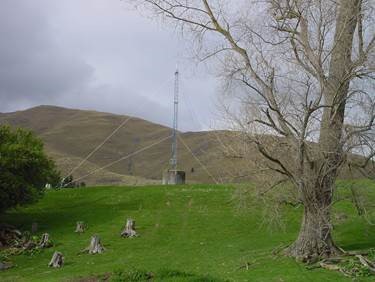
Ken and his team have the clubs tri-bander all carefully assembled, all elements measured and set up ready for the big climb up the lattice.
Lindsay and his team have the new power outlets all operational in the operating room.
Kay with help from Ash and Bright got stuck into cleaning up.
Dave and his team had the Memorial Cairn all tidied up and surrounded by its fine new feature plinth.
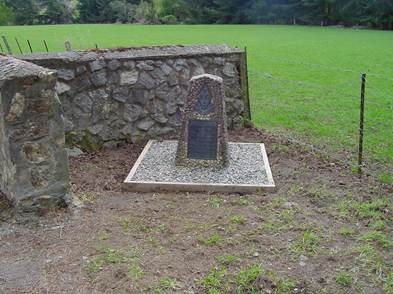
The pole for the 17m beam is all assembled and ready to lift.
And those present – hope my memory doesn’t insult anybody – if I’ve missed you, it is entirely unintentional. We had volunteers from Dunedin, Timaru to the north, Ranfurly to the west and Balclutha to the south.
ZL4DK, ZL4LV, ZL4DC, ZL4ASC, ZL4LDS, ZL4HL, ZL4MJ, ZL4TAE, ZL4JH, ZL4KAY, ZL4RC, ZL4NR, ZL4SA, ZL4OL, ZL4RO, ZL4KS, ZL4TAQ, ZL4BX, ZL4AI, ZL4TIK
Shag Valley Station On Air
Well, ZL4AA, Shag Valley Station is well and truly on the air.
A large team of volunteers from Dunedin, inland Otago, South Otago and ZL2CC from the North Island all converged on the site on Saturday to complete the installation. A number of us were delayed so arrived after lunch to find the amazing sight of Johnny Bell’s Shag Valley Station shearing muster paddock chocker full of vehicles.
The tri-bander had all been checked, ropes shot into the nearby trees to hang a 40m Quad, and 30m Dipole, and the aerials were all in the process of being raised by the teams.
Another team led by Kay ZL4KAY was getting stuck into the cleaning, with husband Harold leading a small team cleaning up the museum.
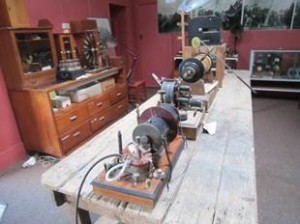
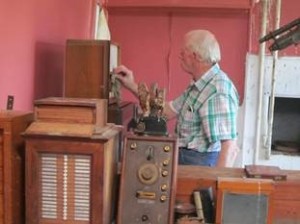
James studying some of the old equipment
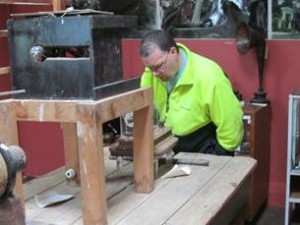
Ross ZL4RC was getting stuck into the kitchen.
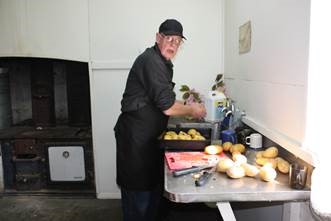
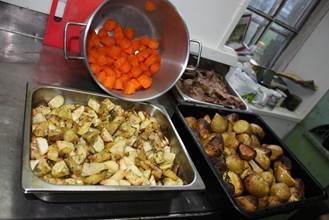
Another team was reinforcing and checking the guys on the lattice tower before the major task of getting the tri-bander up in one piece.
ZL4JH up the mast Steady – almost there!
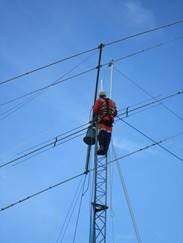 Mike ZL4OL, Adam ZL4 ASC and Hugh ZL4HL – steady goes as they pull the tri-bander up the mast.
Mike ZL4OL, Adam ZL4 ASC and Hugh ZL4HL – steady goes as they pull the tri-bander up the mast.
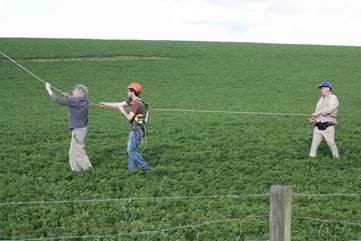
Other were installing the VHF and UHF equipment on the hill behind the paddock as well as the HF and VHF shacks in the historic shearing quarters where everything is based.
Up the mast, the rotator refused to tune, just clicked and juddered so another team set to upgrading the long control lines and once it was turning, the Tri-bander was carefully hoisted and clamped to the rotator.
Peter ZL4LV, Club President ZL4DK and Adam ZL4 ASC study the circuits of the rotator – ah, voltage drop – more copper needed!!
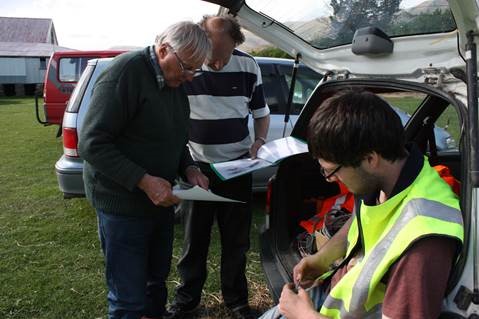
And this is the view or the area from the Lucerne paddock where the 80 m pole and tri-bander are located.
Historic shearers quarters to the left, shearing sheds to the right, block sniffing department (noses)!, 17m beam in the middle, and yes it is well clear of the overhead power lines, an Electrical Engineer positioned it!, and the assembled tri-bander on the ground in front.
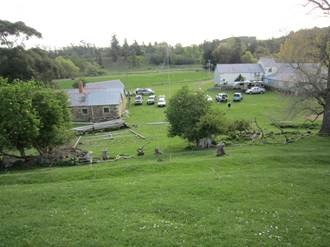
By early afternoon, the team was active on 40 and 80 metres. And two hours later, one of the HF rigs cried enough and refused to transmit. Adam ZL4ASC and Ron ZL4 RMF came to the rescue with rigs from their vehicles so we now have set up two operating HF stations with aerials for:
- 160m – a long wire
- 80m – a ¼ wave counterpoise ground plane vertical
- 40m – a quad hung from the trees
- 30m – a wire dipole hung from the trees
- 20/15/10 – Tri-bander on the 13m lattice tower
- 17m – Yagi on a 11m pole support
And being out in the country, it is nice and electrically quiet!!
And once all the aerials were up, the coaxs out and connected, and all things operating, hunger took over!
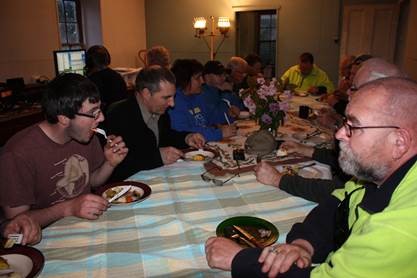
Where to find them – this information from ZL2CC, Mike on site:
80m will be 3.795+- for SSB and 40m will be above 7.130 to allow the W’s general licence to work us. CW will be where there is space ‘down the bottom’. 80m from 06.00 UTC and 40m from about the same time depending on the other bands.
Over the weekend the team have been moving around the band a bit a bit to dodge the contests and so on that were on air.
Kiwis can also find the team on the national System, just call ZL4AA, Shag Valley Station, or for overseas stations, you can try the IRLP. Node 6507 is connected to Dunedin 690 VHF repeater which is accessed from Shag Valley Station.
Will it all go – Mike ZL4OL in front, Ken ZL4NR behind and James observing from the rear.
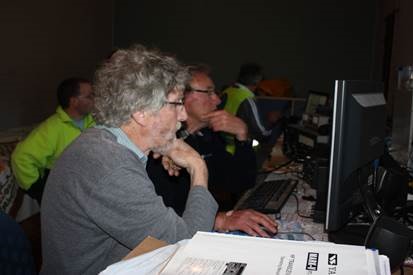
Yep, it is certainly all going and Ken Zl4NR has just reported that 2SZ has been worked on two bands.
And the next week or so:
A small operating team will be on station right through until next Sunday morning. Wednesday night, the Branch 30 club meet will be on site instead of at the Branch headquarters. Just turn up for a coffee and bickie and to see it all happening. Most of those attending are going straight through from work to make sure they are there for the more interesting evening operating time – remember, the Greyline period is around 7-30pm plus or minus around half an hour.
Then from Friday night the team will start gathering for the main event on the anniversary, Saturday 18th at around 7-30pm local time, 0630 UTC . Branch 30 will be supplying afternoon tea and supper and Chrissie from Land SAR will be masterminding an evening BBQ meal for everyone.
And on Sunday, we start pulling it all apart again and returning all the equipment to its owners.
18th Oct 2014
This report was provided by President Dave Mulder, ZL4DK.
Tonight at Shag Valley the ionosphere was good to us and we managed to contact Mill Hill School station 2SZ on 80m CW to replicate Frank Bells contact of 90 years ago.
We also had good copy of 2SZ on 20m SSB and Great Grandson Henry Bell, and Great Granddaughter Lucy Bell were able to talk to current students at Mill Hill School.
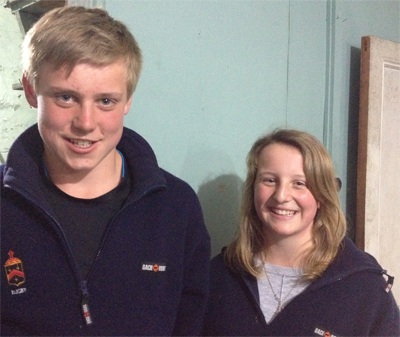
When they were congratulated of the fantastic achievement of their Great Grandfather and Cecil Godyer all those years ago it almost brought tears to the eyes of the crowd gathered in the shearers quarters watching and listening. It felt like the highlight of the week. Thank you Henry and Lucy.
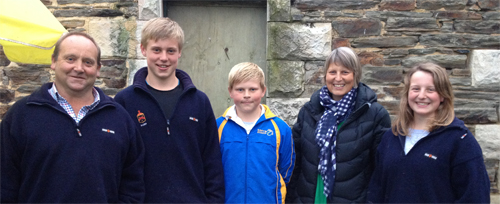
Correspondence
During this occasion ZL4AA received a lot of correspondence. Here's a section of the emails that came in.
Thank you so much for inviting us down to your celebrations last night. What an exciting event! Thank you so much for having Henry and Lucy talk to Mill Hill school. They were very excited to be part of it. It will be something they will remember for ever and make that part of their history so much more alive! Good luck for your clean up! Those aerials certainly looked impressive. We will look forward to having you all back in 10 years time for the big one! Well done on all your hard work. Tanya & Johnny Bell.
I understand the Branch meeting is being held out here at Shag Valley today. A most appropriate venue. It also seems appropriate to show my appreciation for the XLNT work you guys have done. I will deliberately not mention any names as I’m sure there are many who I don’t know about who have had an input into the event. There are two main branches of ham radio; 1/ the ‘giggle hurts’ guys doing the V/UHF and microwaves work and 2/ the HF guys It could be considered that the giggle hurts guys are the cutting edge boys and the HF guys are the ‘old fogies’ working in the last century. What ever……… Many in the club probably don’t know my background but I’m a member of ZL’s top contesting station ZM4T. (though that is about to change as the Chch boys are getting better and better). I thought that as Branch 30 consists mainly of giggle hurts guys you were not the ones to undertake an event steeped in the history of the last century. I was very wrong The branch has done an excellent job here with a very good competitive HF station, well organized. Something you can be proud of and something to look back on in 10 years time. Thank you. Mike S Mather
Well done to all involved with the Shag Valley 90th celebrations: impressive bit of organizing and good publicity for amateur radio at both sides of the globe. 73, Gary ZL2iFB
Just wish to say a BIG THANKS (not shouting) to the team who set up the station and the team of operators who ran the station. I enjoyed the chat and enjoyed the history. ZL2LDX and ZL2KIWI
Tonight, around 40 operators and guests crammed into the Shag Valley Station’s historic shearers quarters recreation room, transformed into a three station HF operation shack, to experience the unreal experience of the re-enactment of Frank Bell’s original contact with Cecil Goyder at Mill Hill School in London. Among the guests were the current land-owners and hosts, Johnny Bell and his family, 5th and 6th generation Bell’s on the station. As the operating team anxiously watched the Greyline simulator on the computer, initial contact was made on 20m with reception, once a clear frequency was found, excellent. This lead to what was the highlight of the evening – Ian at Mill Hill School put two students on the microphone and at our end, Frank Bells great-grand children, Henry and Lucy took the microphone and very quickly got “the lingo” much to the delight of the assembled audience. Maybe Branch 30 has two more budding members? Meanwhile, Ken ZL4NR had tuned up the second rig on 80m while Mike ZL4OL operated and as the Grand-children finished their QSO’s, he quietly announced to the gathering – worked them! The headphone plug was then pulled and the gathering was able to listen to 2SZ working many stations.
Hi, Made contact with your station at 28.515 on the 10 Meter Band,I would like to send my best wishes for your celebration. 73 VA3HNZ-Heinz from Kingsville/Ontario/Canada.
Hello, firstly,congratulations for your celebration of the first around the world transmission,and of course GOOD LUCK!! M6KVT/m
Just like to say a big thanks for the contact on your Special Event and the contact with Ron. VK2UW
Related Links
This section contains some links to resources and coverage of the event.
